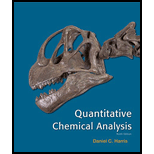
Concept explainers
(a)
Interpretation:
Concentration of Helium in air is given as
5.24 ppm and number of moles of Helium in air at
25.00°C has to be calculated using
Concept Introduction:
Ideal gas equation relates concentration of a gaseous substance with pressure and temperature. The equation representing the relation is given as,
PV = nRT
Where,
P= PressureV= Volumen= Number of moles of the gaseous substanceT= TemperatureR= Universal gas constant
Parts Per Million refers to a term that expresses concentration of certain substance in a mixture of substances. It is denoted as ppm. It is represented as,
ppm = mass of substancemass of sample×106
In solution concentrations, 1 ppm is equivalent to 1 μg/mL or 1 mg/L.
(b)
Interpretation:
Molar concentration of Argon, Krypton, Xenon in air at 25.00°C and 1 bar has to be calculated.
Concept Introduction:
Ideal gas equation relates concentration of a gaseous substance with pressure and temperature. The equation representing the relation is given as,
PV = nRT
Where,
P= PressureV= Volumen= Number of moles of the gaseous substanceT= TemperatureR= Universal gas constant
Molarity, also formal concentration is one of the parameters used to express concentration of a solution. It is defined as the number of moles of the solute dissolved per liter of the solution. It is expressed as,
Molarity = number of moles of solutevolume of solution in L
Parts Per Million refers to a term that expresses concentration of certain substance in a mixture of substances. It is denoted as ppm. It is represented as,
ppm = mass of substancemass of sample×106
In solution concentrations, 1 ppm is equivalent to 1 μg/mL or 1 mg/L.
Parts Per Billion refers to a term that expresses concentration of certain substance in a mixture of substances. It is denoted as ppb. It is represented as,
ppb = mass of substancemass of sample×109
In solution concentrations, 1 ppb is equivalent to 1 ng/mL or 1 μg/L.
Volume percent is one of parameters used to express concentration of a solution and it is defined as percentage of volume of the solute present with respect to volume of the solution. It is expressed as,
Volume percent of a solute = volume of solutevolume of solution × 100%
Trending nowThis is a popular solution!

Chapter 1 Solutions
Quantitative Chemical Analysis
- Don't used hand raitingarrow_forwardCHEM2323 Problem 2-24 Tt O e: ל Predict the product(s) of the following acid/base reactions. Draw curved arrows to show the formation and breaking of bonds. If the bonds needed are not drawn out, you should redraw them. + BF3 (a) (b) HI + (c) OH -BF Problem 2-25 Use curved arrows and a proton (H+) to draw the protonated form of the following Lewis bases. Before starting, add all missing lone pairs. (a) (b) :0: (c) N 1 CHEM2323 PS CH02 Name:arrow_forwardCHEM2323 Problem 2-26 Tt O PS CH02 Name: Use the curved-arrow formalism to show how the electrons flow in the resonance form on the left to give the one on the right. (Draw all lone pairs first) (a) NH2 NH2 + (b) Problem 2-27 Double bonds can also act like Lewis bases, sharing their electrons with Lewis acids. Use curved arrows to show how each of the following double bonds will react with H-Cl and draw the resulting carbocation. (a) H2C=CH2 (b) (c) Problem 2-28 Identify the most electronegative element in each of the following molecules: (a) CH2FCI F Problem 2-29 (b) FCH2CH2CH2Br (c) HOCH2CH2NH2 (d) CH3OCH2Li F 0 0 Use the electronegativity table in Figure 2.3 to predict which bond in the following pairs is more polar and indicate the direction of bond polarity for each compound. (a) H3C-Cl or Cl-CI (b) H3C-H or H-CI (c) HO-CH3 or (CH3)3Si-CH3 (d) H3C-Li or Li-OHarrow_forward
- Reagan is doing an atomic absorption experiment that requires a set of zinc standards in the 0.4-1.6 ppm range. A 1000 ppm Zn solution was prepared by dissolving the necessary amount of solid Zn(NO3)2 in water. The standards can be prepared by diluting the 1000 ppm Zn solution. Table 1 shows one possible set of serial dilutions (stepwise dilution of a solution) that Reagan could perform to make the necessary standards. Solution A was prepared by diluting 5.00 ml of the 1000 ppm Zn standard to 50.00 ml. Solutions C-E are called "calibration standards" because they will be used to calibrate the atomic absorption spectrometer. a. Compare the solution concentrations expressed as ppm Zn and ppm Zn(NO3)2. Compare the concentrations expressed as M Zn and M Zn(NO3)2 - Which units allow easy conversion between chemical species (e.g. Zn and Zn(NO3)2)? - Which units express concentrations in numbers with easily expressed magnitudes? - Suppose you have an analyte for which you don't know the molar…arrow_forwardNonearrow_forwardHow will you prepare the following buffers? 2.5 L of 1.5M buffer, pH = 10.5 from NH4Cl and NH3arrow_forward
 ChemistryChemistryISBN:9781305957404Author:Steven S. Zumdahl, Susan A. Zumdahl, Donald J. DeCostePublisher:Cengage Learning
ChemistryChemistryISBN:9781305957404Author:Steven S. Zumdahl, Susan A. Zumdahl, Donald J. DeCostePublisher:Cengage Learning ChemistryChemistryISBN:9781259911156Author:Raymond Chang Dr., Jason Overby ProfessorPublisher:McGraw-Hill Education
ChemistryChemistryISBN:9781259911156Author:Raymond Chang Dr., Jason Overby ProfessorPublisher:McGraw-Hill Education Principles of Instrumental AnalysisChemistryISBN:9781305577213Author:Douglas A. Skoog, F. James Holler, Stanley R. CrouchPublisher:Cengage Learning
Principles of Instrumental AnalysisChemistryISBN:9781305577213Author:Douglas A. Skoog, F. James Holler, Stanley R. CrouchPublisher:Cengage Learning Organic ChemistryChemistryISBN:9780078021558Author:Janice Gorzynski Smith Dr.Publisher:McGraw-Hill Education
Organic ChemistryChemistryISBN:9780078021558Author:Janice Gorzynski Smith Dr.Publisher:McGraw-Hill Education Chemistry: Principles and ReactionsChemistryISBN:9781305079373Author:William L. Masterton, Cecile N. HurleyPublisher:Cengage Learning
Chemistry: Principles and ReactionsChemistryISBN:9781305079373Author:William L. Masterton, Cecile N. HurleyPublisher:Cengage Learning Elementary Principles of Chemical Processes, Bind...ChemistryISBN:9781118431221Author:Richard M. Felder, Ronald W. Rousseau, Lisa G. BullardPublisher:WILEY
Elementary Principles of Chemical Processes, Bind...ChemistryISBN:9781118431221Author:Richard M. Felder, Ronald W. Rousseau, Lisa G. BullardPublisher:WILEY





